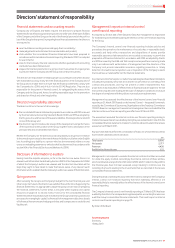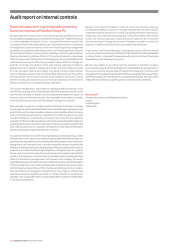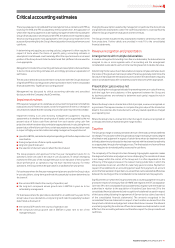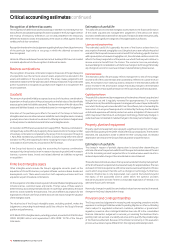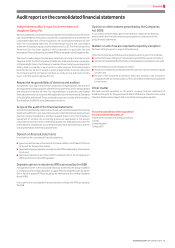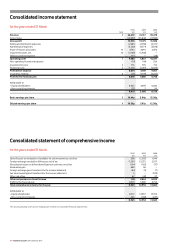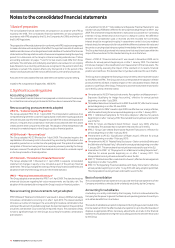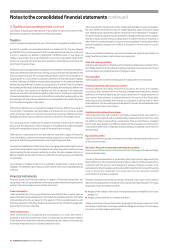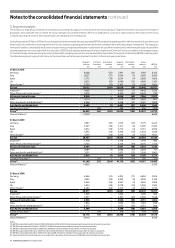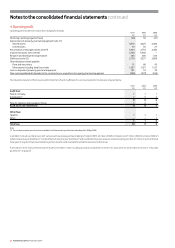Vodafone 2010 Annual Report Download - page 81
Download and view the complete annual report
Please find page 81 of the 2010 Vodafone annual report below. You can navigate through the pages in the report by either clicking on the pages listed below, or by using the keyword search tool below to find specific information within the annual report.
Financials
Vodafone Group Plc Annual Report 2010 79
The results and assets and liabilities of associates are incorporated in the consolidated
financial statements using the equity method of accounting. Under the equity
method, investments in associates are carried in the consolidated statement of
financial position at cost as adjusted for post-acquisition changes in the Group’s share
of the net assets of the associate, less any impairment in the value of the investment.
Losses of an associate in excess of the Group’s interest in that associate are not
recognised. Additional losses are provided for, and a liabilit y is recognised, only to the
extent that the Group has incurred legal or constructive obligations or made
payments on behalf of the associate.
Any excess of the cost of acquisition over the Group’s share of the net fair value of the
identifiable assets, liabilities and contingent liabilities of the associate recognised at
the date of acquisition is recognised as goodwill. The goodwill is included within the
carrying amount of the investment.
The licences of the Group’s associate in the US, Verizon Wireless, are indefinite lived
assets as they are subject to perfunctory renewal. Accordingly, they are not subject
to amortisation but are tested annually for impairment, or when indicators exist that
the carrying value is not recoverable.
Intangible assets
Identifiable intangible assets are recognised when the Group controls the asset, it is
probable that future economic benefits attributed to the asset will flow to the Group
and the cost of the asset can be reliably measured.
Goodwill
Goodwill arising on the acquisition of an entity represents the excess of the cost of
acquisition over the Group’s interest in the net fair value of the identifiable assets,
liabilities and contingent liabilities of the entity recognised at the date of acquisition.
Goodwill is initially recognised as an asset at cost and is subsequently measured
at cost less any accumulated impairment losses. Goodwill is held in the currency
of the acquired entity and revalued to the closing rate at each end of reporting
period date.
Goodwill is not subject to amortisation but is tested for impairment.
Negative goodwill arising on an acquisition is recognised directly in the
income statement.
On disposal of a subsidiary or a jointly controlled entity, the attributable amount of
goodwill is included in the determination of the profit or loss recognised in the
income statement on disposal.
Goodwill arising before the date of transition to IFRS, on 1 April 2004, has been
retained at the previous UK GAAP amounts, subject to being tested for impairment
at that date. Goodwill written off to reserves under UK GA AP prior to 1998 has not been
reinstated and is not included in determining any subsequent profit or loss on disposal.
Finite lived intangible assets
Intangible assets with finite lives are stated at acquisition or development cost, less
accumulated amortisation. The amortisation period and method is reviewed at least
annually. Changes in the expected useful life or the expected pattern of consumption
of future economic benefits embodied in the asset is accounted for by changing the
amortisation period or method, as appropriate, and are treated as changes in
accounting estimates. The amortisation expense on intangible assets with finite lives
is recognised in profit or loss in the expense category consistent with the function of
the intangible asset.
Licence and spectrum fees
Amortisation periods for licence and spectrum fees are determined primarily by
reference to the unexpired licence period, the conditions for licence renewal and
whether licences are dependent on specific technologies. Amortisation is charged
to the income statement on a straight-line basis over the estimated useful lives from
the commencement of service of the network.
All intra-group transactions, balances, income and expenses are eliminated
on consolidation.
Non-controlling interests in the net assets of consolidated subsidiaries are identified
separately from the Group’s equity therein. Non-controlling interests consist of the
amount of those interests at the date of the original business combination and the
non-controlling shareholder’s share of changes in equity since the date of the
combination. Losses applicable to the non-controlling shareholders in excess of the
non-controlling shareholders’ share of changes in equity are allocated against the
interests of the Group except to the extent that the non-controlling shareholders
have a binding obligation and are able to make an additional investment to cover
the losses.
Business combinations
The acquisition of subsidiaries is accounted for using the purchase method. The cost
of the acquisition is measured at the aggregate of the fair values, at the date of
exchange, of assets given, liabilities incurred or assumed, and equity instruments
issued by the Group in exchange for control of the acquiree, plus any costs directly
attributable to the business combination. The acquiree’s identifiable assets and
liabilities are recognised at their fair values at the acquisition date.
Goodwill arising on acquisition is recognised as an asset and initially measured at
cost, being the excess of the cost of the business combination over the Group’s
interest in the net fair value of the identifiable assets, liabilities and contingent
liabilities recognised.
The interest of non-controlling shareholders in the acquiree is initially measured at
the non-controlling shareholders’ proportion of the net fair value of the assets,
liabilities and contingent liabilities recognised.
Where the Group increases its interest in an entity such that control is achieved,
previously held identifiable assets, liabilities and contingent liabilities of the acquired
entity are revalued to their fair value at the date of acquisition, being the date at which
the Group achieves control of the acquiree. The movement in fair value is taken to
the asset revaluation surplus.
Acquisition of interests from non-controlling
shareholders
Acquisitions of non-controlling interests in subsidiaries are accounted for as
transactions between shareholders. There is no remeasurement to fair value of net
assets acquired that were previously attributable to non-controlling shareholders.
Interests in joint ventures
A joint venture is a contractual arrangement whereby the Group and other parties
undertake an economic activity that is subject to joint control; that is, when the
strategic financial and operating policy decisions relating to the activities require the
unanimous consent of the parties sharing control.
The Group reports its interests in jointly controlled entities using proportionate
consolidation. The Group’s share of the assets, liabilities, income, expenses and cash
flows of jointly controlled entities are combined with the equivalent items in the
results on a line-by-line basis.
Any goodwill arising on the acquisition of the Group’s interest in a jointly controlled
entity is accounted for in accordance with the Group’s accounting policy for goodwill
arising on the acquisition of a subsidiary.
Investments in associates
An associate is an entity over which the Group has significant influence and that is
neither a subsidiary nor an interest in a joint venture. Significant influence is the
power to participate in the financial and operating policy decisions of the investee
but is not control or joint control over those policies.


